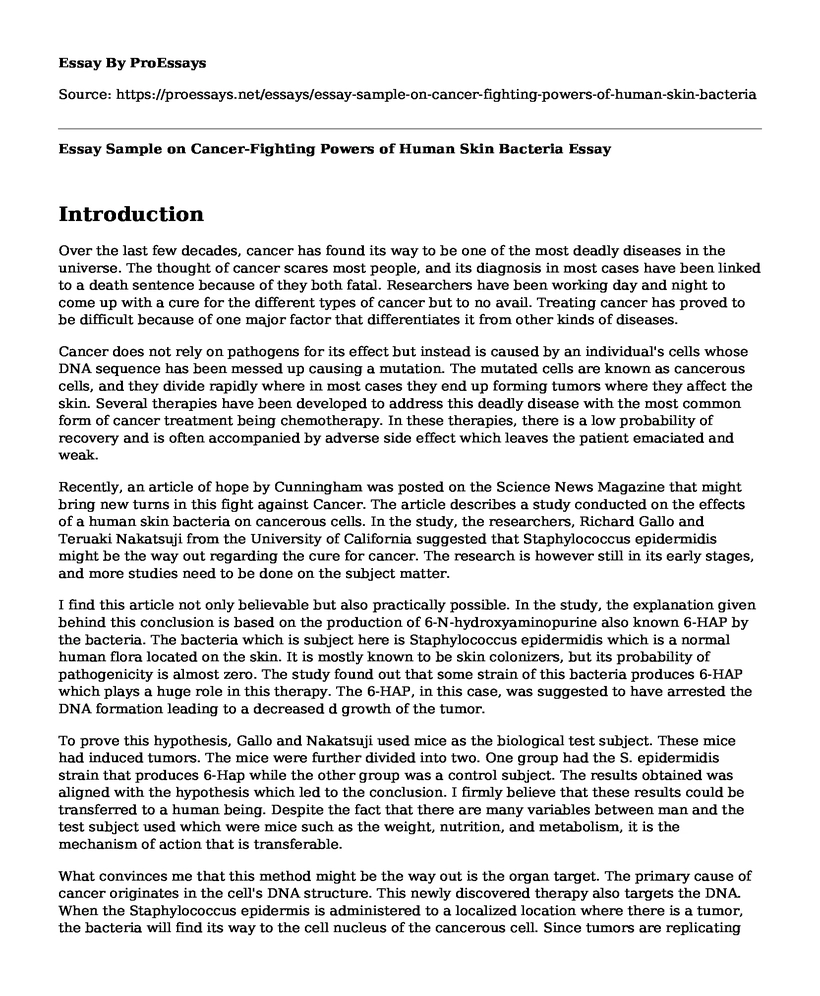Introduction
Over the last few decades, cancer has found its way to be one of the most deadly diseases in the universe. The thought of cancer scares most people, and its diagnosis in most cases have been linked to a death sentence because of they both fatal. Researchers have been working day and night to come up with a cure for the different types of cancer but to no avail. Treating cancer has proved to be difficult because of one major factor that differentiates it from other kinds of diseases.
Cancer does not rely on pathogens for its effect but instead is caused by an individual's cells whose DNA sequence has been messed up causing a mutation. The mutated cells are known as cancerous cells, and they divide rapidly where in most cases they end up forming tumors where they affect the skin. Several therapies have been developed to address this deadly disease with the most common form of cancer treatment being chemotherapy. In these therapies, there is a low probability of recovery and is often accompanied by adverse side effect which leaves the patient emaciated and weak.
Recently, an article of hope by Cunningham was posted on the Science News Magazine that might bring new turns in this fight against Cancer. The article describes a study conducted on the effects of a human skin bacteria on cancerous cells. In the study, the researchers, Richard Gallo and Teruaki Nakatsuji from the University of California suggested that Staphylococcus epidermidis might be the way out regarding the cure for cancer. The research is however still in its early stages, and more studies need to be done on the subject matter.
I find this article not only believable but also practically possible. In the study, the explanation given behind this conclusion is based on the production of 6-N-hydroxyaminopurine also known 6-HAP by the bacteria. The bacteria which is subject here is Staphylococcus epidermidis which is a normal human flora located on the skin. It is mostly known to be skin colonizers, but its probability of pathogenicity is almost zero. The study found out that some strain of this bacteria produces 6-HAP which plays a huge role in this therapy. The 6-HAP, in this case, was suggested to have arrested the DNA formation leading to a decreased d growth of the tumor.
To prove this hypothesis, Gallo and Nakatsuji used mice as the biological test subject. These mice had induced tumors. The mice were further divided into two. One group had the S. epidermidis strain that produces 6-Hap while the other group was a control subject. The results obtained was aligned with the hypothesis which led to the conclusion. I firmly believe that these results could be transferred to a human being. Despite the fact that there are many variables between man and the test subject used which were mice such as the weight, nutrition, and metabolism, it is the mechanism of action that is transferable.
What convinces me that this method might be the way out is the organ target. The primary cause of cancer originates in the cell's DNA structure. This newly discovered therapy also targets the DNA. When the Staphylococcus epidermis is administered to a localized location where there is a tumor, the bacteria will find its way to the cell nucleus of the cancerous cell. Since tumors are replicating cancerous cells, the 6-HAP will curb the replication of the cells reducing the growth of the tumor. Another form of therapy will then chip in at this point to kill the existing cell leaving the individual free from cancer.
From my understanding, the best part about this form of therapy is the "one fix all" concept. All cancer conditions usually originate from defects in the cell's DNA where there is abnormal growth. Survival of all cancers depends on its ability to replicate and also its speed of replication. It means that this therapy can be used to treat all the cancers present in the world because of its similarity in origin and also its mechanism of pathogenicity. In the cases of tumor causing cancers, this therapy will play a huge role in the reduction of tumor masses as tumors are cells which have over replicated.
Previous health statistics indicate that skin cancers have been less prevalent as compared to other forms of cancers such as the lung, breast, and prostate cancers which are the current killer disease. The reason behind this low occurrence might be the presence of Staphylococcus epidermidis which is a normal flora of the skin. Since we co-exist with these harmless bacteria, it might have been possible that for all that while they have been keeping us out of danger without our knowledge.
Conclusion
Having discovered this opportunity to save the world from cancer, it is, therefore, the responsibility of the various stakeholders to pursue its research and come up with a cure for this ailing universe. Who knows, this therapy might be our salvation.
Cite this page
Essay Sample on Cancer-Fighting Powers of Human Skin Bacteria. (2022, May 02). Retrieved from https://proessays.net/essays/essay-sample-on-cancer-fighting-powers-of-human-skin-bacteria
If you are the original author of this essay and no longer wish to have it published on the ProEssays website, please click below to request its removal:
- Sociology Paper Sample: Disabled People's Rights in St. Vincent and the Grenadines
- Physical Activity Advice Only or Structured Exercise Training and Association With HbA1c Levels in Type 2 Diabetes
- Nutrition: A Crucial Factor in Good Health and Why People Fail in It - Essay Sample
- Essay Example on Alabama REACH 2010: Reducing Racial Disparities in Cervical & Breast Cancer
- Essay Example on Public Health & Climate Change: Identifying Populations at Risk
- The COVID-19 Aftermath: How Will the Global Financial System Change? - Essay Sample
- Paper Sample on Nursing Burnout: Argument Against Overtime







